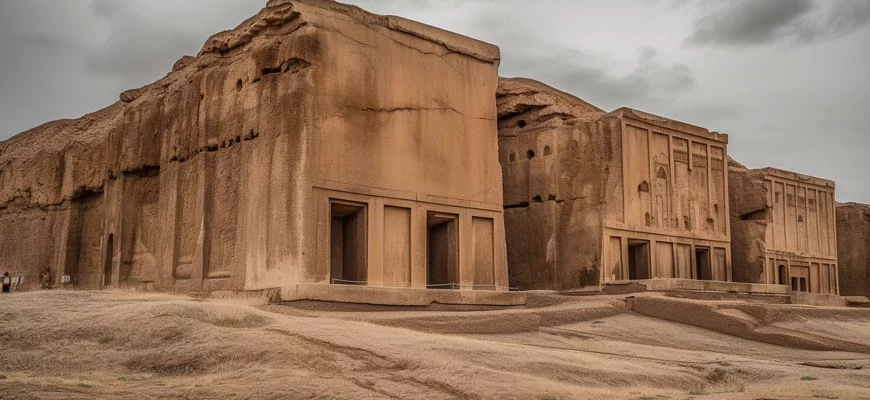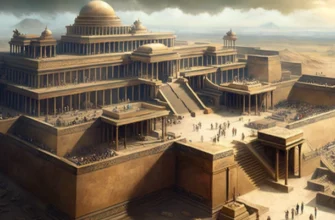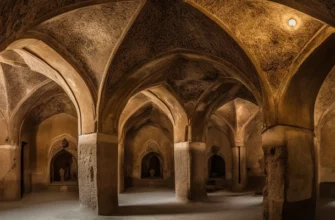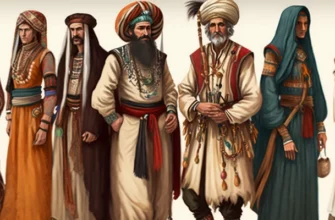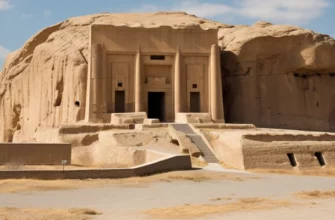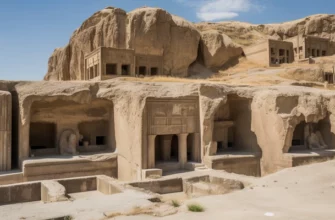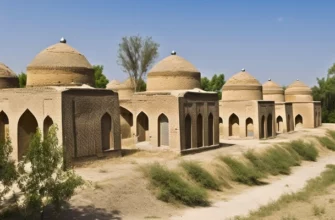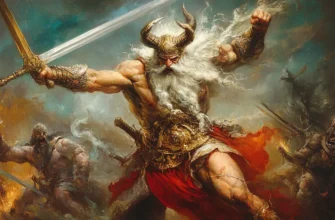Ancient Iran is a cultural and historical region in the Middle East that existed long before our era. Iran occupies a defining place in world history and culture. Its borders contain the oldest archaeological sites, such as Persepolis. The ancient peoples of Iran, such as the Persians and Medes, became important players in the political and cultural spheres, and the Achaemenid and Sassanid empires secured Iran’s recognition as a state. Zoroastrianism, an ancient religion that originated in Iran, played a significant role in the development of the region’s culture and art. Although the empires of Iran no longer exist, the legacy of this ancient region lives on in the culture and traditions of today.
Location and natural conditions
Ancient Iran was located in the territory of modern Iran and some neighboring regions, including parts of modern Iraq, Afghanistan, and Pakistan. The region has a variety of natural conditions, including mountain ranges, deserts, rivers, and oases. The most famous mountain ranges in Iran are the Kopetdag in the north, the Alborz in the southwest, and the Zagros in the west. Iran has a fairly dry climate, but some areas, particularly in the north and west, have higher humidity and a greater variety of vegetation. Iran is also located at the crossroads of trade routes, which provided a link between Europe and Asia and stimulated the development of its economy and culture.
The indigenous peoples of Iran
Various indigenous peoples lived in ancient Iran, including the Elamites, Eritreans, Medes, and Persians. The Elamites were one of the earliest peoples to settle in the region. The Medes became known in the 9th-8th centuries BC and later became an important tribe in Persia. The Persians, who belong to the Indo-European peoples, began to appear in Iran in the 10th-9th centuries BC. They were divided into several tribes but later united into a single Persian state. The Huts, Kassites, Bactrians, and other peoples also lived in Iran. Each of these peoples had their own culture and traditions, which influenced the formation of the cultural heritage of Ancient Iran.
Elam
Elam is one of the oldest peoples who inhabited the territory of Ancient Iran. This people lived in southwestern Iran in the valleys of the Khuzestan and Karun rivers. The Elamites were known for their highly developed culture and art. They made complex ceramic products, used bronze tools, and knew how to write. The Elamites were known for their military power and participated in many wars with neighboring peoples. The Elamite state existed for several millennia until it was conquered by the Achaemenid Empire in the 6th century BC. The Elamites left a significant contribution to the cultural heritage of Ancient Iran, and their influence is evident in many areas, from art to religion and politics.
Media
The Medes were one of the tribes that inhabited the territory of Ancient Iran. They became known in the 9th-8th centuries BC as a military power that covered modern Iran and part of Turkey. The Medes were known for their military might and organization of military forces. In the 6th century BC, the Median king Kyuaksar united the Median tribes and founded the Median state. Later, in the middle of the 6th century BC, the Medes were defeated by the Persians, who conquered their state. The Medes left a significant contribution to the cultural heritage of Ancient Iran, particularly in architecture, crafts, and politics.
Persians
The Persians are one of the oldest peoples to have inhabited the territory of Ancient Iran. They began to appear on the historical scene in the 10th century BC as a tribe living in northern Iran. In the 6th century BC, the Persian leader Cyrus came to power and united the Persian tribes into one state. Later, his descendants, the Persian kings Cambyses and Darius I, expanded the borders of the Persian state and became the founders of the Achaemenid Empire. The Persians were known for their highly developed culture and art. They produced complex ceramic products, knew writing, and had a developed system of government and law. Persian influence is evident in many areas, from art to religion and politics, and remains largely visible in the cultural heritage of Ancient Iran.
The Achaemenid Empire
The Achaemenid Empire is one of the most famous and largest empires that existed in Ancient Iran from the 6th to the 4th century BC. The empire was founded by Persian kings and reached its peak during the reign of Darius I and his son Xerxes I. The Achaemenids became known for their vast territory, which covered parts of modern-day Iran, Afghanistan, Turkey, Iraq, and Syria. The empire was known for its highly developed culture and art, particularly architecture, relief art, and other types of art. The Achaemenids also had a developed system of government and were known for their military prowess and diplomatic skills. The state is associated with such historical events as the conquest of Babylon, the construction of Persepolis, and the wars with the Greeks.
Foundation of the state
The Achaemenid Empire was founded in the 6th century BC by King Cyrus II, who united various Persian tribes and established the first Persian state – the Achaemenid Empire. His descendants—Cambyses I, Cyrus II, and Darius I—continued to expand the territory of the state, conquering neighboring countries and regulating relations with important recognized states of the time. During the reign of Darius I, the Achaemenids became one of the largest and most influential states in the world. The state was founded on the religious and cultural integration of various tribes, which created the basis for its stability and success.
A vast empire
The Achaemenid state became one of the largest empires of the ancient world, covering territories from the Mediterranean Sea to India. The conquest of new territories and the creation of a powerful army were made possible by an effective system of government and a balanced foreign policy. The successful combination of diverse cultures and religions, the stability of national minorities, and the introduction of innovative administrative reforms made the Achaemenid Empire one of the most developed states of its time. The cultural wealth of the state contributed to the development of architecture, art, and science.
Sasanian Empire
The Sasanian Empire was a state that ruled Iran from 224 to 651. It was the successor to the Parthian Empire and was founded as a result of the overthrow of the last Parthian king, Ardavan V, by Ardashir I. During the reign of the Sassanid Empire, there was significant development in the economy, science, and culture. The empire was known for its impressive buildings, magnificent statues, and mosaics. The Sassanid kings were patrons of astronomy, medicine, mathematics, and literature. A number of important historical events also took place during the reign of the Sassanid Empire, including the conquest of Mesopotamia, wars with Rome, and the adoption of Zoroastrianism as the state religion.
Foundation of the empire
The Sassanid Empire was founded in 224 when the Parthian Empire was overthrown by Ardashir I, the first king of the Sassanid dynasty. He united the Iranian tribes living in Persia and created a new state that became the successor to the culture and traditions of the Persian Empire. The founding of the Sassanid Empire marked the beginning of a new phase in the history of Iran, which lasted until the country was conquered by Arab invaders in 651.
Cultural flourishing
The Sassanid Empire was marked by a great cultural flourishing, which manifested itself in architecture, art, literature, and religion. Magnificent palace complexes appeared on the territory of the empire, including the famous Takht-e-Suleiman Palace. The arts of painting, glassmaking, metalworking, weaving, and carpet making were developed. The literary boom contributed to the development of poetry, history, and philosophy. Significant achievements were also made in the field of religion, particularly in Zoroastrianism, the national religion of the Iranians. The Sassanid Empire left its mark on the culture and history of Iran, as well as neighboring countries that adopted and refined certain aspects of Persian culture.
Wars with Rome
Wars with Rome became one of the key elements in the history of the Sassanid Empire. The empires clashed in various wars from 224 to 628 AD. At the beginning of the Sassanid Empire, they managed to win significant victories over Rome, but later the Roman Empire regained its power over parts of Mesopotamia and the Caucasus. The wars between the Sassanid Empire and Rome contributed to the development of military technology and tactics, and also influenced the political and cultural history of both states. Overall, the wars with Rome were of great importance in the history of Ancient Iran and world history as a whole.
Religion and Culture
Ancient Iran had a rich and diverse religious and cultural heritage. One of the main religions was Zoroastrianism, which was formed in the 6th-7th centuries BC and was the dominant religion until the arrival of Islam in the 7th century. Zoroastrianism believed in good and evil as two opposites and claimed that people should fight evil and live according to good.
The second important religion was Mithraism, which also believed in the struggle between good and evil but focused on the cult of Mithra, the god of light and the sun. Other religions also existed in ancient Iran, such as Hinduism and Buddhism, which came to the country from the East.
Culturally, ancient Iran had a rich tradition of art and architecture, which can be seen in the remains of ancient cities such as Persepolis and Susa. The traditions of carpet weaving, pottery, and other artistic crafts were also highly developed. In addition, the ancient Iranians were known for their literature, especially poetry, which depicted heroic deeds and adventures.
Philosophical and scientific research was also developed in ancient Iran. Achievements in mathematics, astronomy, medicine, and other sciences were significant and influenced the development of science in other countries.
Overall, ancient Iran was rich in cultural and religious heritage, with much interaction between different ethnic and religious groups. During the Achaemenid dynasty (6th-4th centuries BC), the first great world empire in history was created, covering territories from India to Egypt and from the Mediterranean Sea to Central Asia.
During this period, a new form of architecture was developed, including royal palaces, mosques, and mausoleums. To facilitate trade, wide roads and bridges were built, and a new system of weights and measures was introduced.
Later, during the Sassanid dynasty (3rd-7th centuries AD), religion became more dogmatic and focused on Zoroastrianism, and a system of class distinctions and restrictions was introduced, leading to greater social inequality. However, during this period, the development of art, science, and literature continued, as did sporting competitions such as hunting and horse riding contests.
Overall, the culture and religion of Ancient Iran have had a significant influence on modern Iranian traditions and culture. Zoroastrianism, although no longer the dominant religion, is still of great importance to Iranian culture and identity, and architectural and artistic traditions continue to this day.
The Fall of Iran
The fall of Ancient Iran was a long and complex process that began as early as the 5th century BC during the conquest of the country by the Macedonian king Alexander the Great. After his death, the country came under the rule of the Seleucids, and later under the influence of the Parthians and the Roman Empire. In the 7th century AD, the country was conquered by the Arabs and converted to Islam.
The fall of Ancient Iran was also linked to the development of new states and cultures in world history. During the Sassanid dynasty, Iran suffered significant territorial losses and wars that exhausted the country and reduced its economic capabilities. After the Islamic Caliphate conquered Iran, power passed to the Arab elite, and the local elites and population became second-class citizens.
Over the following centuries, Iran was influenced by various empires and dynasties, such as the Seljuks, Mongols, Timurids, Safavids, and Qajars. Each of these dynasties contributed to the development of Iranian culture and history.
Iran’s independence was restored in the 20th century after the 1979 revolution, which led to the establishment of the Islamic Republic of Iran. Since then, the country has faced many challenges and crises, but continues to develop as a state and cultural center of the Middle East.
The end of Iran’s ancient history
The end of Iran’s ancient history can be defined in various ways, but it is usually associated with the end of the Qajar dynasty in 1925, when the First Persian Pahlavi dynasty was established. This happened after the Russian Empire and Great Britain opened a railway line through Iran, which allowed them to increase their influence in the country.
The Pahlavi dynasty attempted to implement a series of reforms to modernize the country and raise it to the level of developed states. However, the reforms were insufficient, leading to discontent among the people and a strengthening of the movement for democracy and the establishment of constitutional rights.
In 1979, the Islamic Revolution took place, leading to the overthrow of Shah Mohammad Reza Pahlavi and the establishment of the Islamic Republic of Iran. This marked the end of an era in which Iran was an influential empire and a powerful state in the Middle East.
After the revolution, Iran became an Islamic republic, which still exists today. Iran remains an important player in the Middle East and the world, engaging in geopolitical issues and developing its culture and science.
Conclusions
Ancient Iran, with its rich history and culture, has a significant influence on the modern world. Iran occupies an important place in the Middle East and in world history due to its internal organization, science, art, literature, religion, and more.
One of the most important contributions of ancient Iran to world history is the religion of Zoroastrianism. Zoroastrianism was one of the earliest monotheistic religions, which had a significant influence on other religions, particularly the Judeo-Christian tradition and Islam.
Ancient Iran was also an important center of science, culture, and art. Its dynasties and empires created many masterpieces of architecture, literature, art, and science that are of great historical and cultural significance.
Today, Iran is an important player in the world and in the Middle East. The country continues to develop and contribute to world history and culture.
